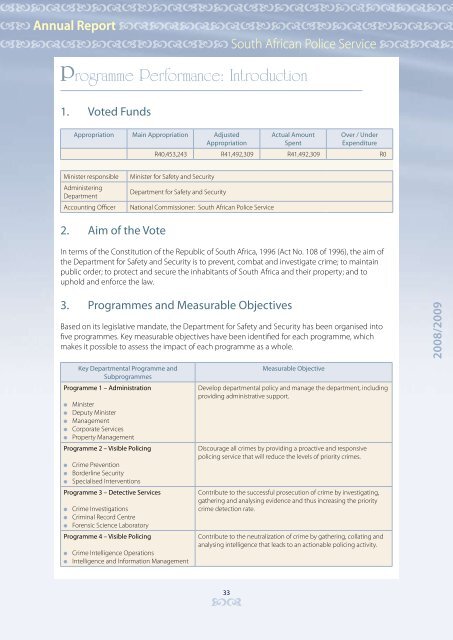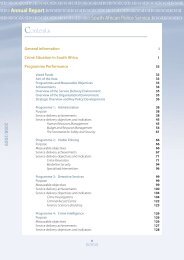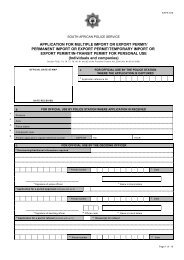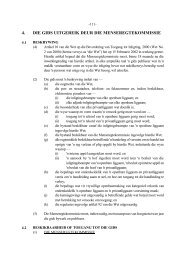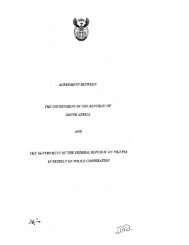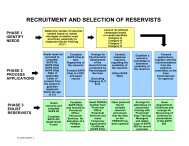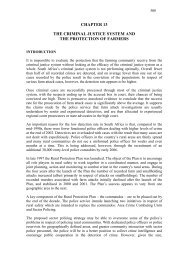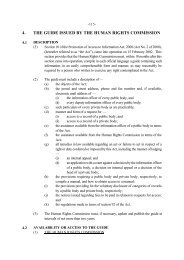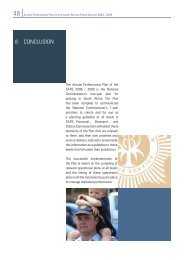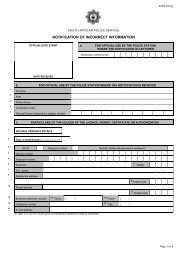Programme Performance: Introduction - Saps
Programme Performance: Introduction - Saps
Programme Performance: Introduction - Saps
Create successful ePaper yourself
Turn your PDF publications into a flip-book with our unique Google optimized e-Paper software.
abcdabcdabcdabcdabcdabcdcdcdcd<br />
ab Annual Report cdcdcdcdabcdabcdabcdcd<br />
abcdabcdabcdabc South African Police Service cdcdc<br />
<strong>Programme</strong> <strong>Performance</strong>: <strong>Introduction</strong><br />
1. Voted Funds<br />
Appropriation Main Appropriation Adjusted<br />
Appropriation<br />
Actual Amount<br />
Spent<br />
Over / Under<br />
Expenditure<br />
R40,453,243 R41,492,309 R41,492,309 R0<br />
Minister responsible<br />
Administering<br />
Department<br />
Accounting Officer<br />
Minister for Safety and Security<br />
Department for Safety and Security<br />
National Commissioner: South African Police Service<br />
2. Aim of the Vote<br />
In terms of the Constitution of the Republic of South Africa, 1996 (Act No. 108 of 1996), the aim of<br />
the Department for Safety and Security is to prevent, combat and investigate crime; to maintain<br />
public order; to protect and secure the inhabitants of South Africa and their property; and to<br />
uphold and enforce the law.<br />
3. <strong>Programme</strong>s and Measurable Objectives<br />
Based on its legislative mandate, the Department for Safety and Security has been organised into<br />
five programmes. Key measurable objectives have been identified for each programme, which<br />
makes it possible to assess the impact of each programme as a whole.<br />
2008/2009<br />
Key Departmental <strong>Programme</strong> and<br />
Subprogrammes<br />
<strong>Programme</strong> 1 – Administration<br />
<br />
<br />
<br />
<br />
<br />
Minister<br />
Deputy Minister<br />
Management<br />
Corporate Services<br />
Property Management<br />
<strong>Programme</strong> 2 – Visible Policing<br />
<br />
<br />
<br />
Crime Prevention<br />
Borderline Security<br />
Specialised Interventions<br />
<strong>Programme</strong> 3 – Detective Services<br />
<br />
<br />
<br />
Crime Investigations<br />
Criminal Record Centre<br />
Forensic Science Laboratory<br />
<strong>Programme</strong> 4 – Visible Policing<br />
<br />
<br />
Crime Intelligence Operations<br />
Intelligence and Information Management<br />
Measurable Objective<br />
Develop departmental policy and manage the department, including<br />
providing administrative support.<br />
Discourage all crimes by providing a proactive and responsive<br />
policing service that will reduce the levels of priority crimes.<br />
Contribute to the successful prosecution of crime by investigating,<br />
gathering and analysing evidence and thus increasing the priority<br />
crime detection rate.<br />
Contribute to the neutralization of crime by gathering, collating and<br />
analysing intelligence that leads to an actionable policing activity.<br />
cd<br />
33
cdabcdabcdabcdabcdabcdcdcdcd<br />
b Annual Report cdcdcdcdabcdabcdabcdcd<br />
bcdabcdabcdabc South African Police Service cdcdc<br />
Key Departmental <strong>Programme</strong> and<br />
Subprogrammes<br />
<strong>Programme</strong> 5 – Protection and Security<br />
Services<br />
Measurable Objective<br />
Minimise security violations by protecting foreign and local<br />
prominent people and securing strategic interests.<br />
<br />
<br />
<br />
<br />
<br />
VIP Protection Services<br />
Static and Mobile Security<br />
Ports of Entry Security<br />
Railway Police<br />
Government Security Regulator<br />
4. Achievements<br />
<br />
Prioritised spending focused on resourcing relating to training interventions, upgrading of<br />
facilities, information technology, radio communication systems, Automated Vehicle Location<br />
System (AVL), new enlistments, vehicles, bullet proof vests, security requirements for the general<br />
elections, the 2009 Confederation Cup and the 2010 FIFA Soccer World Cup, security at ports<br />
of entry and exit, an increased capacity for detective services, forensic scientists and the railway<br />
police. The Service has grown from an establishment of 173 241 at the end of March 2008 to an<br />
establishment of 182 754 at the end of March 2009 in order to address priority crimes, including<br />
contact crimes.<br />
2008/2009<br />
<br />
<br />
To enhance the capacity at station level, 10 484 entry level constables completed the Basic<br />
Training Learning <strong>Programme</strong> (BTLP) after being found competent in the learning areas of<br />
Orientation to the SAPS, Law, Community Service Centre, Crime Investigation, Crime Prevention<br />
and Street Survival.<br />
Integrated law enforcement operations, focusing on a number of priority areas to address the<br />
incidence of contact and contact-related crimes, property-related crimes, crimes dependent on<br />
police action for detection, as well as other serious crime, led to 536 991 priority crime arrests. In<br />
addition, 39 697 wanted persons circulated on all reported cases were arrested by competent<br />
tracing teams as part of the operational strategy adopted to combat violent crime.<br />
<br />
<br />
<br />
<br />
The SAPS contributed to various social crime prevention initiatives relating to the Anti-rape<br />
strategy, the Domestic Violence <strong>Programme</strong>, the Youth Crime Prevention capacity-building<br />
programmes, Violence Prevention programmes, the Victim Empowerment <strong>Programme</strong> and<br />
community-based crime prevention projects in the Integrated Sustainable Rural Development<br />
<strong>Programme</strong> (ISRDP) and Urban Renewal <strong>Programme</strong> (URP) nodes.<br />
Entities such as Business against Crime South Africa, the Primedia Group and Churches against<br />
crime – Community Building Credible Ownership (CBCO) are some of the key strategic partners<br />
of the South African Police Service in addressing specific contact crimes in a proactive manner.<br />
The conviction rate increased by 5,04% to 30,81% for contact crimes, property-related crimes<br />
and crimes dependent on police action for detection, mainly as a result of capacitating the<br />
Criminal Justice System.<br />
A new Forensic Science Laboratory is being built in the Western Cape. The laboratory will use<br />
robotic storage and retrieval systems to archive exhibits, eliminating potential misplacement of<br />
exhibits. A mini-rail transport system of approximately one kilometre will convey larger exhibits<br />
and supplies to the various disciplines within the laboratory. A pneumatic tube system will<br />
cd<br />
34
abcdabcdabcdabcdabcdabcdcdcdcd<br />
ab Annual Report cdcdcdcdabcdabcdabcdcd<br />
abcdabcdabcdabc South African Police Service cdcdc<br />
transport smaller exhibits and related items between the various sections for analysis purposes.<br />
The laboratory will make use of solar heating and intelligent lighting to make the facility energy<br />
efficient.<br />
<br />
The Railway Police environment was expanded by establishing infrastructure in the form of<br />
six new railway police stations in Bellville and Philippi in the Western Cape, Escombe and<br />
Cavendish in KwaZulu-Natal and Mount Ruth and Swartkops in the Eastern Cape. 15 055 arrests<br />
for priority crimes were made in the railway environment.<br />
5. Overview of the Service Delivery Environment in 2008/2009<br />
An assessment of the external environment in which the SAPS operates has led to the identification<br />
of a number of major issues that not only direct the performance of the SAPS, but also the broader<br />
public’s perceptions of its ability to fight crime effectively. These issues not only impact on the<br />
way in which the SAPS carries out its policing mandate, but also on the safety and security of the<br />
country, the African continent and the Southern African Development Community (SADC) region,<br />
of which South Africa is an integral part.<br />
<br />
The promoting of constructive local-level partnerships, the structured implementation of sector<br />
policing and the promoting of active participation by the community in community policing<br />
forums, remains a challenge in order to increase interaction on issues of crime.<br />
<br />
<br />
The reduction of levels of serious and violent crime, specifically contact crimes, is influenced<br />
by a moral decline in society and the economic recession. The incidence of serious and violent<br />
crime is also magnified by the occurrence of civil unrest and disturbance, primarily motivated<br />
by local dissatisfaction with the standard of service delivery provided by local government.<br />
The country’s borderlines and ports of entry and exit are targeted by national and international<br />
criminal elements. Transnational crime afflicts South Africa, which impacts on its neighbours<br />
and other countries within the international community.<br />
2008/2009<br />
6. Overview of the Organisational Environment for 2008/2009<br />
<strong>Performance</strong> within the service delivery environment is largely dependent on a structured,<br />
well-resourced and well-managed organisational environment. In ensuring the support of the<br />
organisational environment to improve service delivery across all areas that the SAPS is responsible<br />
for, the organisation has prioritised and pursued certain key challenges.<br />
<br />
<br />
<br />
Professionalism supports improved service delivery but is undermined by ill-discipline and<br />
corruption and fraud by SAPS personnel members. Dealing with the incidence of poor<br />
service delivery, corruption and fraud in the SAPS was and remains a significant challenge for<br />
management and personnel at all levels.<br />
Improving the investigation processes within the Criminal Justice sector through the continued<br />
capacitation of detective branches at local level and the Criminal Record and Forensic Science<br />
environment with adequate skilled people remains a challenge for the SAPS.<br />
A number of organizational matters have had a negative impact on the public’s perceptions of<br />
the SAPS, including escapes from police custody, the involvement of SAPS members in fraud<br />
and corruption and the misuse and abuse of state resources, including firearms and vehicles. It<br />
cd<br />
35
cdabcdabcdabcdabcdabcdcdcdcd<br />
b Annual Report cdcdcdcdabcdabcdabcdcd<br />
bcdabcdabcdabc South African Police Service cdcdc<br />
remains a priority of the SAPS to reduce the incidence of these organisational matters in order<br />
to improve service delivery, organisational performance and public perceptions.<br />
7. Strategic Overview and Key Policy Developments for the<br />
2008/2009 Financial Year<br />
The key documents governing policing policy are section 205 of the Constitution of the Republic<br />
of South Africa (1996), the South African Police Service Act (1995) and the 1996 National Crime<br />
Prevention strategy. The aim of the strategy is to improve the Department’s capacity to prevent,<br />
combat and investigate crime.<br />
7.1 Strategic and operational priorities<br />
Over the medium term, the Department focused on the key operational priorities outlined in its<br />
2005 to 2010 strategy: combating organised crime; serious and violent crime, and crime against<br />
women and children; and improving basic service delivery to communities. The key organisational<br />
priorities that underpin these operational priorities are human resources, budgeting and managing<br />
other resources.<br />
7.2 The South African Police Service and the Integrated Justice System<br />
2008/2009<br />
The Department for Safety and Security is an integral part of the Justice, Crime Prevention and<br />
Security Cluster, which coordinates interdepartmental crime prevention and security initiatives<br />
across the integrated justice system. The cluster priorities relating to the SAPS are: improving<br />
public safety by preventing and reducing crime; focusing on contact crime by developing<br />
programmes to reduce social crime; conducting integrated law enforcement operations and<br />
entering into partnerships with the organs of civil society and communities; addressing organised<br />
crime; improving the effectiveness of the integrated justice system; improving the levels of<br />
national security by managing the strategy on border security, among others; and developing<br />
and implementing safety and security measures for the 2009 general elections, the 2009 FIFA<br />
Confederations Cup and the 2010 FIFA World Cup.<br />
7.3 Community and sector policing<br />
Crime prevention in South Africa is based on the principles of community policing, recognizing the<br />
interdependence and shared responsibility of the police and the community in establishing safety<br />
and security. Key to this approach is establishing active partnerships between the police and the<br />
public to jointly address crime and community safety issues. Community policing forums are one<br />
of the main ways in which this is done.<br />
Sector policing is regarded as an enabling mechanism for organizing and mobilizing communities<br />
at the micro level (for example within the boundaries of neighbourhoods or sectors) to bring<br />
the police service closer to the community. Sector policing focuses on combining police and<br />
community capabilities by launching joint projects to address the causes of crime and identify hot<br />
spots and vulnerable communities.<br />
cd<br />
36
abcdabcdabcdabcdabcdabcdcdcdcd<br />
ab Annual Report cdcdcdcdabcdabcdabcdcd<br />
abcdabcdabcdabc South African Police Service cdcdc<br />
7.4 Reducing contact crimes<br />
Government intends to reduce contact crimes by between 7 and 10 per cent a year, including<br />
crimes against women and children. The 169 high-contact crime stations are the main focus for this<br />
target. In the context of high crime rates, Government aims to stabilise and then reduce the levels<br />
of crime through improved policing and complementary social development and communitybased<br />
initiatives, supported by various government departments.<br />
7.5 Capacity building<br />
To improve the South African Police Service’s capacity to perform its service delivery functions<br />
at local level, the total number of personnel is expected to reach approximately 204 860 by<br />
the end of March 2012 (from 182 754 at the end of March 2009). This larger establishment will<br />
be complemented by the expansion of the Department’s vehicle fleet, equipment supplies,<br />
technological infrastructure and the number of reservists.<br />
Given the integrated nature of policing, identified policing priorities are not contained<br />
individually or collectively in any single programme. Rather, these priorities underpin<br />
the operational activities undertaken at all levels and across all divisions of the SAPS in<br />
the context of the entire programme structure. The overall success achieved by the SAPS<br />
extends across all the financial programmes, as all SAPS employees have contributed either<br />
directly or indirectly in this regard. However, specific areas in which success was achieved<br />
are discussed in the context of specific programmes.<br />
The reporting framework for programme performance is in accordance with the “Estimates<br />
of National Expenditure 2008, Vote 22, Safety and Security, the SAPS Strategic Plan for 2005-<br />
2010 and the Annual <strong>Performance</strong> Plan for 2008/2009. Tables 1, 7, 20, 24 and 25 reflect the<br />
output, indicators and actual performance against set targets.<br />
2008/2009<br />
cd<br />
37


